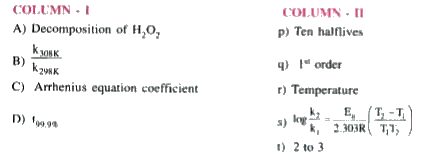The energy of activation for a reaction is 100 kJ/mol at 57∘C. Presence of catalyst lower activation energy by 25%. The rate of reaction is increased by 10x the value of x is Solution in Telugu
The correct Answer is:4
r2r1=K2K1=A.e−Ea2/RtA.e−Ea1/RT,10x=e−εa2+εa2RT
2.303log1010x=εa1−εa2RT,2.303×x=(100−75)×1038.314×330,x=25×10008.314×330×2.303=3.95≅4
Topper's Solved these Questions
- BOOK - AAKASH SERIESCHAPTER - CHEMICAL KINETICSEXERCISE - PRACTICE SHEET-4 (SINGLE OR MORE THAN ONE OPTION QUESTIONS)16videos
CHEMICAL KINETICS
- BOOK - AAKASH SERIESCHAPTER - CHEMICAL KINETICSEXERCISE - PRACTICE SHEET-4 (LINKED COMPREHENSION TYPE QUESTIONS)6videos
CHEMICAL KINETICS
- BOOK - AAKASH SERIESCHAPTER - CHEMICAL KINETICSEXERCISE - PRACTICE SHEET-3 (MATCH THE FOLLOWING QUESTIONS)2videos
CHEMICAL KINETICS
- BOOK - AAKASH SERIESCHAPTER - CHEMICAL KINETCSEXERCISE - EXERCISE - 3.245videos
CHEMICAL KINETCS
- BOOK - AAKASH SERIESCHAPTER - CHEMICAL THERMODYNAMICSEXERCISE - Additional Practice Exercise54videos
CHEMICAL THERMODYNAMICS
Similar Questions
In general the rate of a given reaction can be increased by all the factors except
04:38View SolutionA follows parallel path first order reaction to give B and C as given below (Take antilog (0.156)=1.428)

Initial conc of A is 0.2 M
The overall rate constant of the reaction is02:49View SolutionMatch the following columns
 03:01View Solution
03:01View SolutionDiscuss on the kinetic spontaneity of a chemical reaction. Is a slow reaction spontaneous? Why?
04:38View SolutionWhich among the following is not an exact differential?
06:41View SolutionIn the presence of catalyst, the activation energy of the reaction is lowered by 2 kcal at 27^(@)C . The rate of reaction will increased by
03:09View SolutionAt 27∘C in the presence of a catalyst, the activation
?energy of a reaction is lowered by 2 kcal. Calculate
by how much the rate of reaction will increase ?07:47View SolutionThe activation energy of a first order reaction at 300 K is 60 kJ "mol"^(-1) . In the presence of a catalyst, the activation energy is lowered to 50 kJ "mol"^(-1) at the same teperature. How many times the rate of reaction will change ?
04:19View SolutionIn the presence of a catalyst, the activation energy of a reaction is lowered by 2 kcal at 27^(@)C . The rate of reaction will increase by
View Solutionकिसी अभिक्रिया की सक्रियण ऊर्जा उत्प्रेरक की अनुपस्थिति में 70.5 kJ mol तथा उत्प्रेरक की उपस्थिति में 50.5 kJ/mol है। उत्प्रेरक की उपस्थिति में अभिक्रिया का वेग कितने गुना बढ़ जायेगा यदि अभिक्रिया 30∘C पर होती है ?
02:29View SolutionThe energy of activation for a reaction is 100 kJ/mol. Presence of a catalyst lowers the energy of activation by 75%. The ratio of kcat/Kuncat at (T=298K) is :
03:22View SolutionThe activation energy of a reaction is 100 kJ/mol. In the presence of catalyst the activation energy is decreased by 75%. What is the effect on rate constant of the reaction at 20^@ C ?
01:01View SolutionThe energy of activation for a reaction is 50kJ/ mol. Presence of a catalyst lowers the energy of activation by 25%. What will be the effect on rate of reaction at 30∘ C- Other things remains same.
05:22View SolutionA hydrogenation reaction is carried out at 500K. If the same reaction is carried out in presence of catalyst at the same rate, the temperature required is 400K. Calculate the activation energy of the reaction if the catalyst lowers the activation energy barrier by 20kJ/mol.
04:14View SolutionA catalyst lowered the energy of activation by 25 kJ mol^(-1) .How many times , the rate reaction increases?
View Solution

